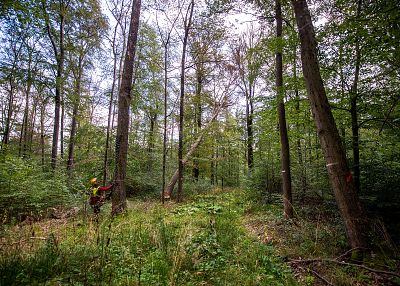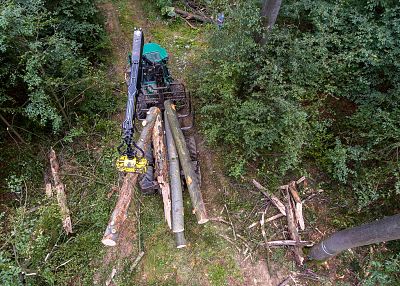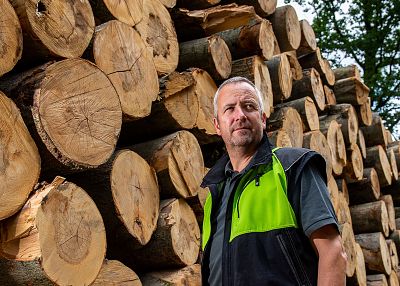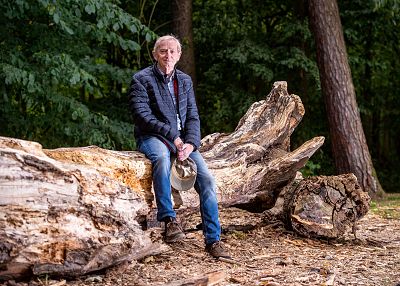Millions of trees are at risk of succumbing because of devastating heat. "The situation is catastrophic," said one lumberjack.
HAINICH, Germany — As forester Dirk Fritzlar walks through thick woodland on a sunny September morning, it starts to "rain" spruce needles.
"It is not normal for the trees to shed so many needles. It is far too dry. Many spruce trees are dying," Fritzlar said as he peeled off a piece of bark. He quickly finds a colony of bark beetles that are a major threat to the spruce — a common species in German forests.
In the last two years, Germany has experienced long summer droughts and rising temperatures, both of which are putting the country's woodlands in peril.
The potential fate of this forest and millions of German trees shows the danger climate change and changing weather patterns pose to biodiversity and raises questions of how states and citizens should protect their local green spaces.
In 2018 alone, 110,000 hectares (about 272,000 acres) of forest area in Germany were damaged and 33 million cubic meters of wood — equivalent in volume to 12 Great Pyramids of Giza — were declared dead, researchers at the country's Thünen Institute of Forest Ecosystems said.
A preliminary assessment for 2019 shows at least the same amount of damage.
German researchers and foresters have told NBC News the damage is the result of high temperatures and lack of rain drying out the trees, and in the case of the spruce, weakening its defenses against pests such as the bark beetle.
During a heat wave that hit much of Europe in July, Germany was one of several countries to break records, recording temperaturesas high as 42.6 degrees Celsius (108.7 F).
Fritzlar, 52, prays for rain every day.
"Essentially, we could use a full eight weeks of rain. There is not enough water in the ground," says Fritzlar, who oversees more than a dozen districts in eastern Germany's Hainich forest, an ancient woodland and UNESCO world heritage site.
Half of Hainich was designated as a national park in 1997 and is protected.
In another part of the woodland that Fritzlar helps manage, lumberjacks are at work, chopping down a damaged beech tree, a predominant species in the area.
"The situation is catastrophic," one of the workers calls out as he drags cut-down trees out of the underbrush with heavy machinery.
For generations, forests that cover one third of the country have been an integral part of Germany's cultural heritage and identity.
But with so much of the woodland visibly in despair this year, the damage has shocked visiting Germans.
Fritzlar believes up to 30 percent of the older beech tree population in the managed part of Hainich has been severely damaged.
"We estimate that nearly 50,000 beech trees, which are more than a century old, are affected," he said.
Dr. Tanja Sanders, head of forest ecology and biodiversity at the Thünen Institute, explains that some beech trees have suffered the equivalent of a sunburn during the droughts and are slowly dying.
Sanders said older trees in Hainich are likely to be taller, and so are more exposed to high temperatures and prone to leaf damage. At such heights, sucking up enough water can be a real effort.
"The question is whether the forest would have been growing here in this composition if humans had no influence," she said.
"The spruce might be having problems as we planted it in locations that are not perfectly suitable for it. Beech trees likely were the natural vegetation in central Europe, but beech exposed to high radiation and having low humidity do suffer as well."
Nearly half of the country's forests are privately owned, and witnessing the death of so many trees can be devastating for the families who have built their livelihoods around them.
"These are family enterprises," Larissa Schulz-Trieglaff, spokeswoman for the Association of German Forest Owners, said. "Some of them live only from the forest, and for them, it's an existential crisis."
Helge Bruelheide, professor of geobotany, at Martin Luther University in Halle, Germany, said that damage caused by drought has been seen in beech, spruce, birch, maple and even in more drought-resistant oak trees.
"It's really dramatic. You can see it everywhere," he said. "Driving around Germany, you will see dead patches of trees in many regions."
And for people venturing out into the woodland to hike or relax, it can be tough, Bruelheide said. "You see a tree that's dying, and you can't do anything about it."
For Hermann Mueller, 71, who heads a local hiking club with 58 members, the forest is an essential part of his life. Living close to Hainich, he has been hiking through the woods and across meadows since early childhood.
"It is our green lung. It hurts to see it ailing," Mueller said.
"I never thought it would get so bad that you have to be afraid that branches fall on your head when you enter the woods," Mueller said.
Bright yellow signs around the park now warn hikers of increased danger.
Climate change, and in particular the impact of heat waves and droughts on the forests, have been part of public discourse in Germany for months.
Front pages of Germany's leading newspapers and magazines have been asking whetherthe country's forests can still be saved.
In terms of what can be done about it, Bruelheide said tackling climate change is more of a long-term solution, but in the short-term there is no one simple remedy that can fix the "bleak" situation.
He said reforestation and the introduction of drought-resistant tree species are not a solve-it-all answer because it can be expensive and takes decades, while there is no guarantee that even oaks, which tolerate drought better, will do well.
Scientists, environmental organizations and representatives from Germany's forest industry gathered in Berlin this month to discuss ways to help the forests.
"Every missing tree is a missing comrade-in-arms against climate change," agriculture minister Julia Klöckner told the public broadcaster SWR ahead of the summit, as Germany is mulling a 800 million euro ($880 million) rescue effort.
Back in Hainich, Fritzlar is convinced a mixed, tree species-rich forest is the answer.
"It's a complex task that we face for the future," he said. "This must be a wake-up call."















